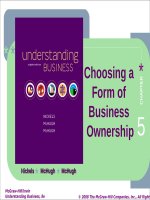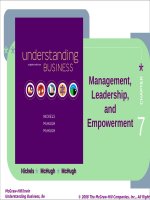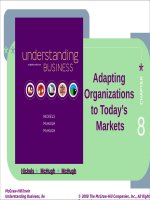Understanding business 8th by mcchugh nickels chapter 05
Bạn đang xem bản rút gọn của tài liệu. Xem và tải ngay bản đầy đủ của tài liệu tại đây (952.98 KB, 29 trang )
*
*
*
Choosing a
Form of
Business
Ownership
Nickels
*
McHugh
McGraw-Hill/Irwin
Understanding Business, 8e
*
*
CHAPTER
**
5
McHugh
1-1
5-1
© 2008 The McGraw-Hill Companies, Inc., All Rights
*
*
*
Basic Forms of
Business Ownership
Type of Ownership
Number
Sales
Sole Proprietorship
72%
6%
Partnership
8%
13%
Corporation
20%
81%
Source: US Internal Revenue Service
5-2
*
*
*
Sole Proprietorship
Advantages
•
•
•
•
•
•
Ease of start/end
Be your own boss
Pride of ownership
Leave a legacy
Retain profit
No special taxes
Disadvantages
•
•
•
•
•
•
•
Unlimited liability
Limited financial
resources
Management difficulty
Time commitment
Few fringe benefits
Limited growth
Limited life span
5-3
*
*
*
Types of Partnerships
Genera
l
Limite
d
GP
GP
GP
Passive
Investor
GP
Passive
Investor
GP
Passive
Investo
r
5-4
*
*
*
New Forms of
Partnerships
• Master Limited Partnership
• Traded Publicly
• Taxed As A Partnership
• Limited Liability Partnership
5-5
*
*
*
Partnership
Advantages
• More financial
resources
• Shared
management
• Longer survival
• No Special
Taxes
Disadvantages
• Unlimited
liability
• Division of
profits
• Disagreements
among
partners
• Difficult to
5-6
*
*
*
Types of Corporations
• Conventional ‘C’
• S Corporation
• Limited Liability Companies
5-7
*
*
*
Corporations
•
Private: Not Traded on Any
Stock Exchange
•
Public: Shares are Traded on
One or More Stock Exchanges
•
Non-Profit: Performs Public
Service, Has Special Tax
Considerations to Encourage
Formation
5-8
*
*
*
Corporation
Advantages
• Limited liability
• More money for
investment
• Size
• Perpetual life
• Ease of ownership
change
• Ease of drawing
talented
employees
• Separation of
ownership/mgmt.
Disadvantages
• Extensive
paperwork
• Double taxation
• Two tax returns
• Size
• Termination
difficult
• Conflict with
Stockholder &
Board
• Initial cost
5-9
*
*
*
World’s Largest
Corporations
1. Citigroup
2. General Electric
3. American Intl Group
4. Bank of America
5. HSBC Group
6. ExxonMobil
7. Royal Dutch/Shell
8. BP
9. ING Group
10. Toyota Motor
11.UBS
12.Wal-Mart Stores
13.Royal Bank of Scotland
14.JP Morgan Chase
15.Berkshire Hathaway
16.BNP Paribas
17.IBM
18.Total
18.Verizon Communication
20.Chevron Texaco
Source: Forbes, 2005
5-10
*
*
*
America’s Largest
Private Companies
Revenue 2004
(In Millions)
1.
2.
3.
4.
5.
Cargill / agricultural commodities, food
$66,669
Koch Industries / chemicals, energy, tech
60,000
Mars / candy, pet food electronics
19,100
PricewaterhouseCoopers / accounting
18,700
Publix Supermarket / supermarkets
18,686
Source: Forbes, 2005
5-11
*
*
*
America’s Oldest
Companies
Company
Year Started
Type of Company
J. E. Rhoads & Sons
1702
Conveyer Belts
Covenant Life Ins.
1717
Insurance
1752
Insurance
Contributorship
Dexter
1767
Adhesives & Coatings
D. Landreth Seed
1784
Seeds
Bank of New York
1784
Banking
Philadelphia
5-12
*
*
*
GM’s Ownership In:
Source: USA TODAY
5-13
*
*
*
How Owners Affect
Management
5-14
*
*
*
S Corporations
• No more than 100 • 1 class of stock
shareholders
• <25% of income
• Individual or
can be passive
Estates
• Benefits change
• U.S. citizens or
with new tax
permanent
rules
residents
5-15
*
*
*
Limited Liability Companies
Advantages
• Limited Liability
• Tax Choice
• Flexible Ownership
Rules
• Flexible Profit &
Loss Distribution
• Operating Flexibility
Disadvantages
• No Stock
• Limited Life Span
• Fewer Incentives
• Taxes
• Paperwork
5-16
*
*
*
Types of Mergers
Horizontal
Vertical
Conglomerate
No
Relationship
between
companies
5-17
*
*
*
Leveraged Buyout
Individual
+
Loan
= Purchase of
Company
Purchase Loan
Company =
Collateral
5-18
*
*
*
Why Mergers Don’t Work!
•
Companies Overpay to
Acquire Another Firm
•
Acquiring Company
Overestimates Cost Savings
and Synergies
• Managers Disagree About
Integrating Operations
• Obsession with Cost Cutting Hurts Business,
Costing Top Employees & Customers
5-19
*
*
*
Franchise System
• Franchise
Agreement
• Franchisor
• Franchisee
5-20
*
*
*
Franchise Contract
Franchisor, Inc.
Branded
Product/Servic
e
Performanc
e
$$$$$
Monitoring
Franchisee
5-21
*
*
*
Franchisor
•
Assigns Territory
•
May Provide
Financial Aid/Advice
•
Offers Merchandise/
Supplies at
Competitive Price
•
Provides
Training/Support
•
Business
Expansion Using
O.P.M.
5-22
*
*
*
Franchisee
• Pays Up-Front Costs
• Makes Monthly Payment to
Franchisor
• Runs Business by Franchisor’s
Rules/Procedures
• Buys Materials from Franchisor/
Approved Supplier
5-23
*
*
*
Franchises
Advantages
•
Management &
marketing assistance
•
•
•
Personal ownership
•
Lower failure rate
Recognized name
Financial advice &
assistance
Disadvantages
•
•
•
•
•
•
High start-up costs
Shared Profit
Management regulation
Coattail effects
Restrictions on selling
Fraudulent franchisors
5-24
*
*
*
Cost of Fast-Food
Franchise
Company
Initial Fee
Royalty
Burger King
$50,000
8.5%
McDonald’s
$45,000
8%
Wendy’s
$25,000
8%
Domino’s
None
8.5%
Subway
$10,000
11.5%
Krispy Kreme
$40,000
5.5%
5-25









